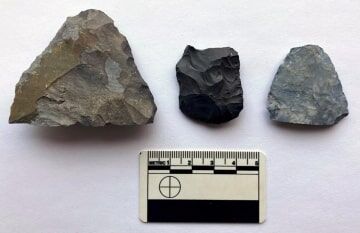Kent State professors find over 600 ancient tools in Holmes County

Photos of archeological discoveries made by Kent State archeologists and university professors Michelle Bebber and Metin Eren. Several potential artifacts washed up on the shore of Lake Erie Edgewater Park in Cleveland, Ohio.
September 15, 2021
Kent State Professors Metin Eren and Michelle Bebber found that sometimes what you’re looking for comes when you’re not looking at all.
Eren and Bebber went about 70 miles from campus to Holmes County in search of artifacts. While the desired research location was a dead end, Bebber saw something out of the corner of her eye where they parked.
“I’m like, ‘wait a minute,’” Bebber said. “In this huge plowed cornfield, there were hundreds of artifacts just laying on the surface that I parked beside and never noticed.”
A plow came through the area and mixed all the artifacts together, making it hard to know what used to be in the area. However there’s evidence that the area was a hunting camp, early settlement or a village.
They found 662 specimens in one hour and there’s still some they had to leave behind. The specimens date back 2 to 5 thousand years in the Late Archaic and Early Woodland periods.
According to the report published by Bebber and Eren, they range from arrowheads to scraper tools. Many of them show signs of being sharpened and re-sharpened. They only analyzed 62 of the artifacts, but all of them are now in the hands of the Cleveland Museum of Natural History.
They received an overwhelmingly positive response from the press and the people of Holmes County where Bebber is from. They did a presentation for over one hundred people explaining how old those artifacts were and demonstrating how one would make tools 5 thousand years ago.
Both Eren and Bebber are specialized in experimental archaeology. Eren has done research across the world, but one of his biggest findings was in Olduvai Gorge, Tanzania.
“We found artifacts in a pyroclastic flow, so basically a volcano erupted and the humans on the landscape got caught up in that flow, which would have wiped them out,” Eren said.
The tools found in this old flow suggested that the East African landscape would have been devastated by volcanic activity from time to time. They found that the humans who lived there probably had to recolonize after this, making it a huge finding for Eren and his colleagues.
The same goes for Bebber, who started her career in pottery, but realized her love for the field when she began replicating ancient pottery. Since graduate school she has focused her personal research on early copper use in North America and has an ongoing project in a Stow rockshelter trying to identify recently discovered animal bones.
One thing Bebber and Eren can agree on is their focal point in teaching experimental archaeology at Kent State. Neither of them will pass up an opportunity to do field work, but they have a passion for the research side of archaeology.
“I don’t get as excited about field discoveries as I do when we test and get results from something in the lab here,” Eren said.
While they both prefer to be in the labs, they are Archaeologists through and through. Bebber recently found animal bones at her new site in Stow that she is hoping can lead to something big. With the site being a rockshelter, she hopes that it amounts to what she expected to be in Holmes.
Mateo Martin covers research and the environment. Contact him at [email protected].











